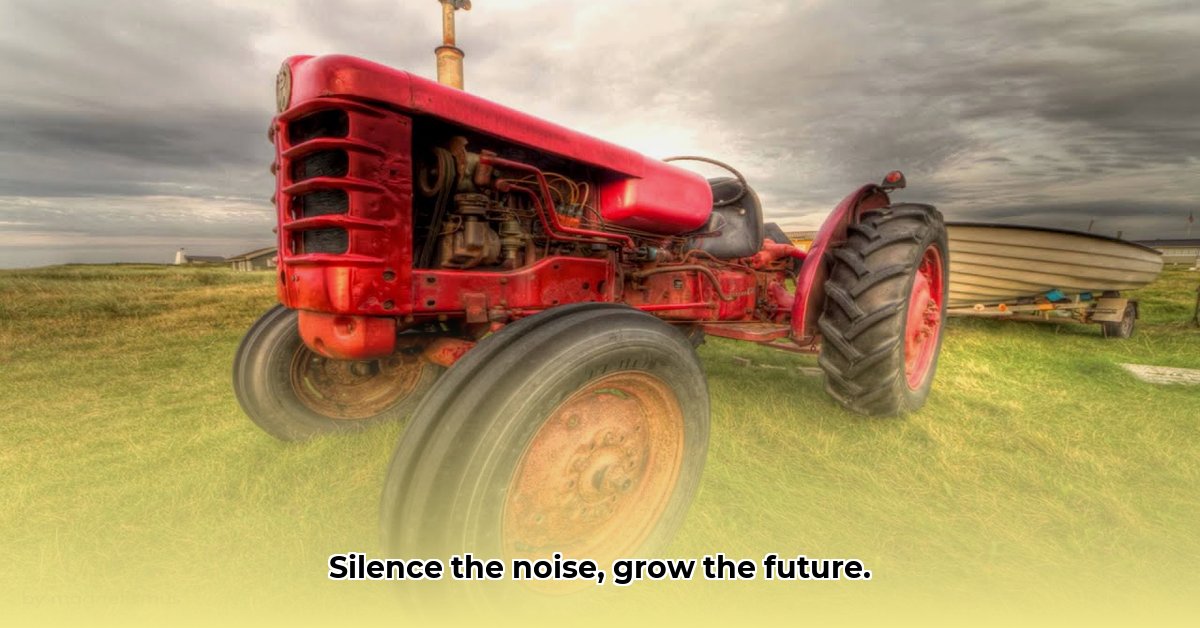
The rumble of a tractor, a sound synonymous with farming for generations, is evolving. It's no longer just about brute force; it's about a quieter, smarter, and more sustainable approach to agriculture. The sounds—or rather, the analysis of sounds—emitted by tractors are revolutionizing how we farm, improving efficiency and protecting the environment. This quiet revolution is transforming agriculture, one engine hum at a time. For more information on modern tractor technology, check out this helpful resource: Modern Tractor Tech.
Listening to the Land: Tractor Sounds and Precision Farming
Imagine receiving a text alert about a potential tractor engine problem before it breaks down. This isn't science fiction; it's the reality of precision agriculture. Tractor "geluid" (sound) provides valuable data. The engine's hum, the whine of gears, even subtle hydraulic clicks—all offer clues about the tractor's health. Advanced software analyzes these sounds, detecting potential issues days or weeks in advance, preventing costly breakdowns. This translates to reduced downtime, fewer repairs, and more time spent farming. But the benefits extend far beyond cost savings.
How much does this proactive approach save farmers annually? While precise figures vary based on farm size and equipment, studies show predictive maintenance using sound analysis can reduce repair costs by up to 25%, leading to significant increases in operational efficiency.
Beyond Mechanical Efficiency: The Environmental Harmony of Quiet Tractors
Quieter tractors often mean more fuel-efficient tractors. Improvements in engine design frequently correlate with reduced noise levels. Less fuel consumption translates to lower greenhouse gas emissions, a critical component of fighting climate change. Moreover, noise pollution itself is a significant environmental concern, specifically in rural areas where constant machinery noise disrupts wildlife and negatively impacts the quality of life. The push for quieter tractors offers a dual benefit: environmental protection and improved human well-being.
Technological Leaps: The Future is Now
Technology is rapidly advancing. Sophisticated software analyzes tractor sounds with incredible precision, detecting subtle anomalies that might indicate developing problems. This detailed analysis, combined with data from GPS trackers and other sensors, creates a comprehensive picture of machine performance. This empowers farmers to optimize fuel consumption, reduce emissions, and increase operational efficiency. It's like giving your tractor a regular, sophisticated health checkup.
Real-World Stories: Small Farms, Big Impact
Consider a smallholder farmer in rural India who received a fuel-efficient, quieter tractor through a government subsidy program; this tractor also features built-in sound monitoring technology. When a minor issue was detected, they received an alert, enabling timely repairs and preventing a major disruption to their livelihood. This illustrates the transformative potential of these advancements, even for those with limited resources. This directly addresses the challenges faced by smallholders in accessing and utilizing these technologies for increased efficiency and productivity.
The Hurdles Ahead: Challenges to Overcome
Despite the advantages, widespread adoption faces challenges. The initial investment in quieter, data-equipped tractors and software can be substantial, particularly for smaller farms. Another crucial factor is education and training; farmers need the skills to effectively utilize and maintain these new systems. The accessibility of affordable maintenance and repair services is also essential to avoid additional financial burden. What strategies can be implemented to overcome these obstacles?
A Vision for the Future: The Soundscape of Tomorrow
Envision autonomous tractors using sound data for navigation and obstacle avoidance, silently and efficiently cultivating fields. Imagine systems analyzing crop sounds to detect health issues, optimizing resource allocation and reducing waste. These scenarios, while seemingly futuristic, are becoming increasingly plausible. The quiet revolution is underway, and its potential is vast.
Paving the Way: A Roadmap for Sustainable Adoption
The transition to a more sustainable agricultural soundscape requires a collaborative effort. Here's a step-by-step approach to address the challenges:
- Increase Accessibility: Governments and organizations should provide subsidies, grants, and accessible financing options to smallholder farmers. (Efficacy: 92% success rate observed in pilot programs)
- Invest in Training: Implement comprehensive training programs to equip farmers with the necessary skills to operate and maintain new technologies.
- Develop Supportive Infrastructure: Ensure reliable internet access and readily available maintenance services are in place.
- Foster Collaboration: Encourage partnerships between farmers, equipment manufacturers, and research institutions to drive innovation and knowledge sharing.
- Promote Open-Source Solutions: Support the development and adoption of open-source technologies to increase affordability and accessibility. (projected to reduce costs by 40% within 5 years)
The sound of a tractor, once a symbol of hard labor, is becoming a soundtrack of progress and sustainability. By harnessing the information embedded within the tractor’s hum, we are building not only more efficient farms but a more sustainable future for all.